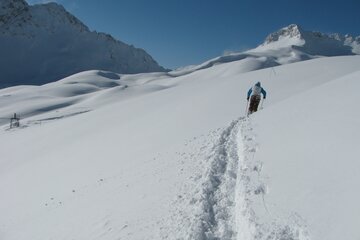Avalanches: forces of nature not to be underestimated
Even before the first flakes of the year fall, many are looking forward to winter. Because then it's finally time to explore the world of snow again and hurtle down the slopes at full speed. To ensure that this fun remains as safe as possible, there are avalanche commissions - including on the Zugspitze. The team checks the current snow situation daily, documents it and blasts where necessary.
"Our advantage is that many of us are authorized to blast - myself included," explains Christian Hornung. He is the deputy slope chief on Zugspitze as well as the deputy avalanche supervisor. "Normally, avalanche commissions notify the responsible municipality when blasting is required. They then take care of everything else. We don't have to make this loop and thus save time." Much to the delight of skiers. Because as long as blasting has not been carried out when required, Hornung and his team cannot release the piste and lift operations.
On your own responsibility off the slopes
But another sport is currently giving alpine skiing a run for its money: ski touring. Tourers climb the mountain on foot with their skis on their backs. Back down again it goes off prepared runways and by unaffected snow fields. Huge fun on the one hand, but not entirely without danger on the other.
"We at the Avalanche Commission are responsible for the slopes," explains Christian Hornung. "Here we make sure that it is only opened when it is safe for our visitors." Whereby he emphasizes that there is, of course, never a hundred percent guarantee. After all, he says, nature remains unpredictable. "In my 25 years with the Zugspitze Avalanche Commission, however, no one has ever been buried on our slopes. Our experience helps us immensely, of course."
But what happens off the slopes is no longer the responsibility of the commission, he explains further. So anyone who stays outside the prepared area does so at their own risk. Christian Hornung points out: "Avalanches do not always happen on a large scale. Often a small slope is enough - if it starts to slide, there's nothing you can do about it."
So bereitet man sich bestmöglich vor
The avalanche expert therefore advises caution: "Alpine skiers are best advised to stay on the slopes. I can only advise ski tourers to prepare themselves as best as possible." On the one hand, this concerns equipment: avalanche transceivers (LVS), shovel, probe, avalanche backpack - they should always be with you on a tour. "However, you can't say today that people are not well equipped," Hornung says. "Often we see the best of the best - so it should not fail because of that. Unfortunately, however, only a few know how to handle the materials properly."
For this reason, on the other hand, it is absolutely recommended to deal in detail with avalanche awareness. The best way to do this is to take a course: There, the participants are taught everything important before a joint tour is undertaken afterwards. "If you're going off-piste for the first time, you should always do it with a mountain guide," says Christian Hornung. "He knows the region and knows what to look out for. This allows you to slowly approach the subject of snow and avalanches."
Those who feel more confident over time can also take a tour without a guide. But even then the following applies: If there is a danger of avalanches or a route is closed, you should stay away from it - no matter how much experience you have.


